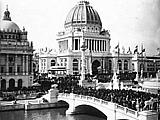
Saving the Fair
GRHC - November 4th, 2013
A Grand Rapids businessman, Melvin Church, while visiting Chicago, suggested an innovative solution to an engineer during the construction of the World's Fair that allowed the fair to open on schedule.
Transcript
Melvin B. Church was noted as an inventor of useful chemical processes and articles. Among his earliest productions were wall finishes known as “Alabastine.” Calcined gypsum, changed to lime by heating, is the base of alabastine, and Grand Rapids had plenty of gypsum.
In 1892, while visiting Chicago, Church went to Jackson Park to watch the progress being made in the construction of buildings for the World’s Fair, Columbian Exposition. The fair celebrated the 400th anniversary of Christopher Columbus’ arrival in the new world.
Church saw hundreds of men spreading paint with brushes and concluded that the job could not possibly be finished before May 1, 1893, the day set for the opening of the fair.
He suggested to the engineer in charge, a method to speed up the painting of the buildings. Using tanks supplied with pumps and applying paint with a garden hose would complete the project much earlier.
Recognizing the feasibility of Church’s suggestion the engineer engaged him to construct the pumps needed. When the apparatus was put into operation a few weeks later, it served the purpose so well that others were provided with equipment. The job was finished weeks in advance of the opening day.
Unfortunately, Mr. Church spent a great deal of time and much money in litigation in the United States and foreign countries to recover damages for infringements of his patent.
Full Details
| Title | Saving the Fair |
|---|---|
| Creator | GRHC |
| Keywords | WYCE; radio; Grand Rapids; Historical Commission; Chicago; World's Fair; Columbian Exposition; Melvin Church |
| Duration | 2:11 |
| Pubdate String | November 4th, 2013 |

 facebook
facebook